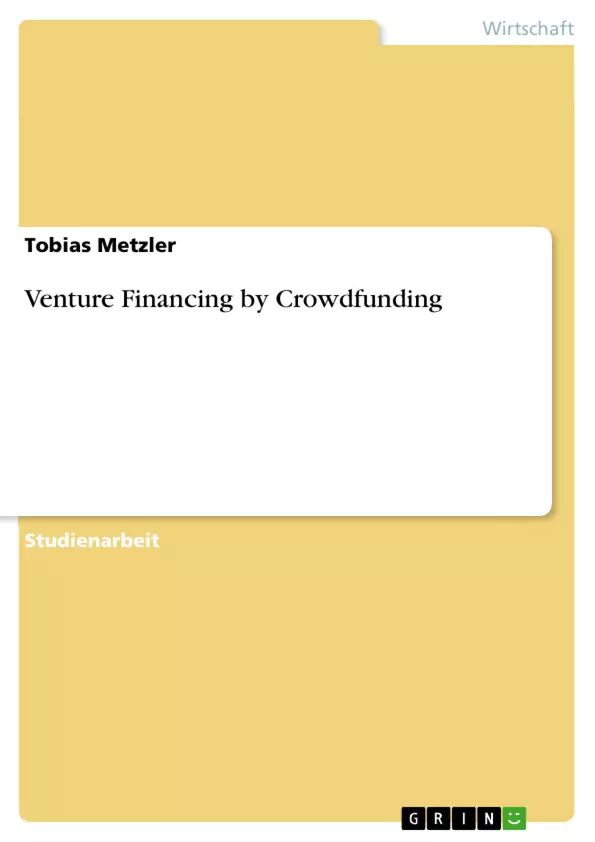What are the similarities of a garden that can be hung with magnets on the wall, a fleet of pollution collecting sailing drones and a bracelet which merges with the iPod touch to a watch? All three have made the leap from an idea to a real product. And all three were financed by crowdfunding.
In theory, before the discovery of crowdfunding, individuals have been indirectly financed projects by their savings. In doing so, banks acted as an intermediary between them who need the money and those who have it. The innovation in crowdfunding process is in comparison to other financing methods that it don´t needs an intermediary, because the entrepreneurs seek their investors by themselves. The typical communication takes place via the internet.
Crowdfunding is an option of financing which is especially used for artistic projects. It is also used to finance startups in information and communication, design, fashion or trade industry. The special thing about crowdfunding is the collection small amounts of money from many people by using the internet. Every amount is just a small part of the fund they need to achieve the project. If a project is successful, the investors might even receive interests on their deployed capital, but mostly they receive another form of reward.
Crowdfunding it is not just to raise funds, it is also the collection of information. Moreover, it is often advantageous for the project that it passes through the crowd the process of funding a higher level of awareness. This is essential for the future commercialization. Furthermore, one gets the investors feedback that can be incorporated in the development. Since investors usually slip into the role of the customer, it can be seen as an exchange of information between the organization and the customers. Often it is not only a pure crowdfunding financing. It can be a hybrid financing, in which a certain proportion of the required funding is obtained via crowdfunding, and the other part is obtained by usual forms of financing.
Inhaltsverzeichnis
- 1. Introduction
- 2. The world of crowdfunding...
- 2.1. Crowdfunding tools...
- 2.1.1. Crowdsourcing
- 2.1.2. Web 2.0......
- 2.1.3. Fundraising
- 2.1.4. Social Media
- 2.2. Different forms of crowdfunding...
- 2.2.1. Donations......
- 2.2.2. Passive investments...
- 2.2.3. Active investments
- 2.3. Advantages of using crowdfunding .......
- 2.4. Choice of the organization form.......
- 2.5. Limit and problems of crowdfunding.
- 2.6. Forms of financing.
- 2.6.1. Differences in support.
- 2.6.2. Differences in risk..........\n
- 2.6.3. Differences in volume.......
- 2.6.4. Similar forms of fincancing
- 2.7. Geography and history of crowdfunding.
- 2.7.1. Crowdfunding in Germany..\n
- 2.7.2. Crowdfunding in Europe......
- 2.7.3. International Crowdfunding......
- 2.8. Practical example - the project “Protei”.
- 3. Conclusion
Zielsetzung und Themenschwerpunkte
Dieses Seminarpapier befasst sich mit dem Thema Venture Financing durch Crowdfunding. Es analysiert die verschiedenen Formen des Crowdfundings, die Vorteile und Nachteile dieser Finanzierungsmethode sowie die Herausforderungen und Chancen für Unternehmen, die diese nutzen möchten. Das Papier beleuchtet außerdem die Entwicklung des Crowdfundings in Deutschland, Europa und weltweit.
- Die verschiedenen Formen und Mechanismen des Crowdfundings
- Die Vorteile und Nachteile von Crowdfunding im Vergleich zu traditionellen Finanzierungsformen
- Die Rolle des Crowdfundings in der Finanzierung von Startups und Innovationen
- Die rechtlichen Rahmenbedingungen und Herausforderungen des Crowdfundings
- Die Entwicklung des Crowdfundings in Deutschland, Europa und weltweit
Zusammenfassung der Kapitel
Kapitel 1: Introduction
Dieses Kapitel führt in das Thema Crowdfunding ein und stellt den Kontext der Arbeit dar. Es zeigt auf, wie Crowdfunding eine alternative Finanzierungsform für innovative Projekte und Startups bietet, die nicht auf traditionelle Finanzierungsquellen angewiesen sind.
Kapitel 2: The world of crowdfunding
Dieses Kapitel beschäftigt sich mit den verschiedenen Formen und Aspekten des Crowdfundings. Es erläutert die unterschiedlichen Crowdfunding-Tools und -Plattformen, die für verschiedene Zwecke eingesetzt werden, sowie die Vorteile und Herausforderungen dieser Finanzierungsmethode. Es werden zudem verschiedene Formen des Crowdfundings, wie Spenden, passive und aktive Investitionen, vorgestellt und die unterschiedlichen Risiken und Möglichkeiten dieser Formen analysiert.
Schlüsselwörter
Crowdfunding, Venture Financing, Startups, Innovation, Finanzierung, Finanzierungstools, Spenden, passive Investitionen, aktive Investitionen, Crowdsourcing, Web 2.0, Social Media, Rechtliche Rahmenbedingungen, Deutschland, Europa, weltweit.
- Arbeit zitieren
- Tobias Metzler (Autor:in), 2011, Venture Financing by Crowdfunding, München, GRIN Verlag, https://www.grin.com/document/176160



